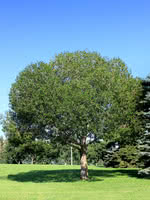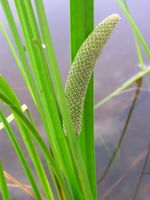Mon-Fri 9am - 5pm Mountain time
Laurel Leaf Willow vs American Sweet Flag
Salix pentandra
Acorus americanus
CUSTOM GROW
Laurel Leaf Willow is a round-shaped tree with attractive dark green leaves.
This cold hardy tree can withstand bitter winters and still put on lots of growth every summer. Laurel Leaf Willow prefers moist to wet ground and full sun, though it can tolerate partial shade too. This species is also known as one of the more salt-tolerant species for those with saline soils.
All willow are important to native pollinators each spring as they have higher amounts of pollen and nectar early each growing season when other food sources are scarce.
American Sweet Flag is a native perennial wetland plant found along shorelines, streams, wet meadows, and marshes. Its extensive rhizome system allows it to spread and stabilise soil, helping maintain the edges of ponds and streams. This dense growth provides cover for small animals and supports overall wetland biodiversity, while the rhizomes and seeds serve as food for small mammals and waterfowl. Cold-hardy and resilient, it is well-suited for ecological restoration, riparian plantings, erosion control, and naturalization projects.
The plant grows in dense clumps with tall, sword-shaped leaves that release a citrus-like scent when bruised. The rhizomes are aromatic, with a spicy, cinnamon-like fragrance that has been used in perfumery and flavouring. In early summer, American Sweet Flag produces a distinctive floral spike (spadix), adding visual interest to wetland plantings.
Laurel Leaf Willow Quick Facts
American Sweet Flag Quick Facts
In row spacing: 2.4 - 3 m (8 - 10 ft)

